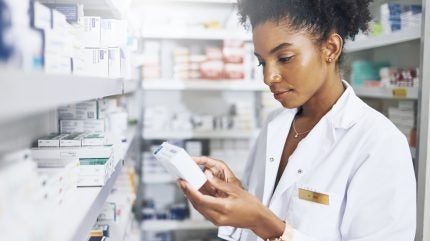
While drug formulation rightly receives significant attention, packaging is equally crucial — it ensures stability, prevents contamination, facilitates correct usage, and even deters counterfeit activity.
With technological advances and heightened regulatory focus, pharmaceutical packaging is undergoing a transformation that promises smarter and safer outcomes.

Discover B2B Marketing That Performs
Combine business intelligence and editorial excellence to reach engaged professionals across 36 leading media platforms.
This article explores the key innovations and enduring trends shaping the future of pharma packaging.
Integrating smart technology into packaging
Smart packaging — once the stuff of science fiction — is now becoming mainstream in the pharmaceutical industry. These intelligent systems go far beyond simply housing a product.
They are designed to enhance patient adherence, monitor environmental conditions, and provide authentication, all through embedded technology.
One notable innovation is the rise of electronic labels and packaging that can remind patients when to take their medication. These packages often include printed sensors or electronic circuits connected to mobile apps.

US Tariffs are shifting - will you react or anticipate?
Don’t let policy changes catch you off guard. Stay proactive with real-time data and expert analysis.
By GlobalDataBy tracking usage patterns, these systems can alert users to missed doses or even warn healthcare providers of non-compliance, a particularly valuable feature for patients managing chronic illnesses.
Time-temperature indicators (TTIs) are another smart feature gaining traction.
These devices change colour when a product has been exposed to temperatures outside its safe range — a critical feature for biologics and vaccines that require cold chain integrity.
For global pharmaceutical supply chains, TTIs provide a visual assurance of proper handling, reducing the risk of administering compromised medicines.
Radio-frequency identification (RFID) tags and QR codes are also becoming standard.
These technologies enable real-time tracking of products through the supply chain, bolstering transparency and reducing the chance of diversion or counterfeit substitution. A simple scan can now verify the origin and authenticity of a product, empowering pharmacists and consumers alike.
Tackling counterfeit medicines through packaging innovation
Counterfeit drugs remain one of the most pressing issues facing the global pharmaceutical industry, particularly in regions with less robust regulatory oversight.
According to the World Health Organization, one in ten medical products in low- and middle-income countries is either substandard or falsified. Packaging, therefore, is on the front line of defence.
Tamper-evident packaging has become a key requirement in many jurisdictions, particularly across the EU under the Falsified Medicines Directive (FMD). Features such as breakable seals, shrink bands, and perforated closures provide clear visual cues that a package has been opened or interfered with.
These measures, while relatively low-tech, are effective deterrents against tampering and reassure patients of product integrity.
More sophisticated solutions are also emerging, including forensic markers, holograms, and microtext printing — all of which are difficult to replicate. Some companies have even begun embedding invisible inks and DNA-based identifiers into packaging materials, detectable only with specialised equipment.
These innovations serve as powerful tools in authentication, helping customs officials, distributors, and healthcare professionals verify legitimacy.
Serialisation, now required in many countries, is another major leap forward. It involves assigning a unique serial number to every saleable unit of medication. When coupled with a central database, this allows regulators and manufacturers to track each unit across its lifecycle — from production to patient.
The technology not only combats counterfeiting but also facilitates targeted recalls and improves inventory management.
Sustainability and patient-centric design
As environmental concerns take centre stage, pharmaceutical companies are under increasing pressure to adopt sustainable packaging solutions. The industry has traditionally relied on plastics and other non-biodegradable materials to ensure product sterility and durability.
However, new materials and design philosophies are emerging that balance safety with environmental responsibility.
Recyclable blister packs, compostable cartons, and biodegradable films are gaining popularity. Paper-based alternatives to plastic inserts and trays are already being trialled, and some companies are exploring plant-based polymers that decompose naturally.
These efforts are not without their challenges — especially when it comes to maintaining moisture resistance and barrier protection — but the direction of travel is clear.
Patient-centric design is also reshaping pharmaceutical packaging. Easy-to-open containers, clearly labelled instructions, and accessible design for individuals with visual or physical impairments are becoming more common.
This is not merely a matter of convenience; research shows that user-friendly packaging can significantly improve adherence to treatment regimens.
Child-resistant features remain a vital component, but the focus is shifting towards dual-purpose packaging that protects young children while remaining manageable for elderly users.
Innovations like push-turn caps with tactile indicators and audible clicks are subtle yet impactful steps in the right direction.
Final thoughts
The future of pharmaceutical packaging lies at the intersection of technology, safety, sustainability, and design.
As manufacturers respond to stricter regulations, smarter consumer expectations, and a more connected global marketplace, packaging is evolving from a passive container into a dynamic guardian of health.
The move towards smarter and safer solutions is not only enhancing product integrity but also placing greater control into the hands of patients and providers.
This evolution is set to continue. From digital companions that track doses to tamper-proof seals that guarantee authenticity, the journey of a medicine from factory to patient is being redefined.
In a world where health outcomes often hinge on precision and trust, pharmaceutical packaging is no longer an afterthought — it is a frontline technology.





